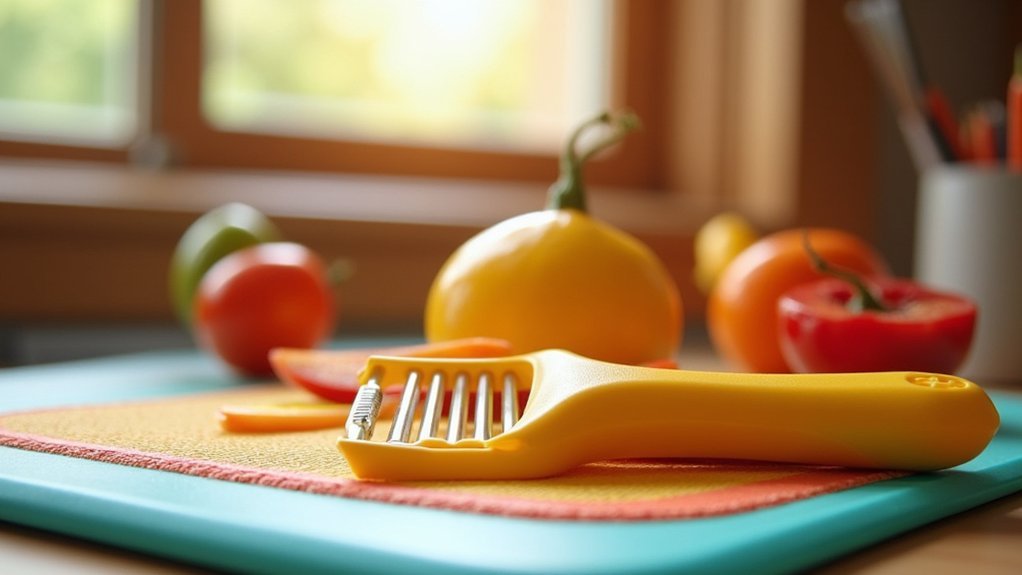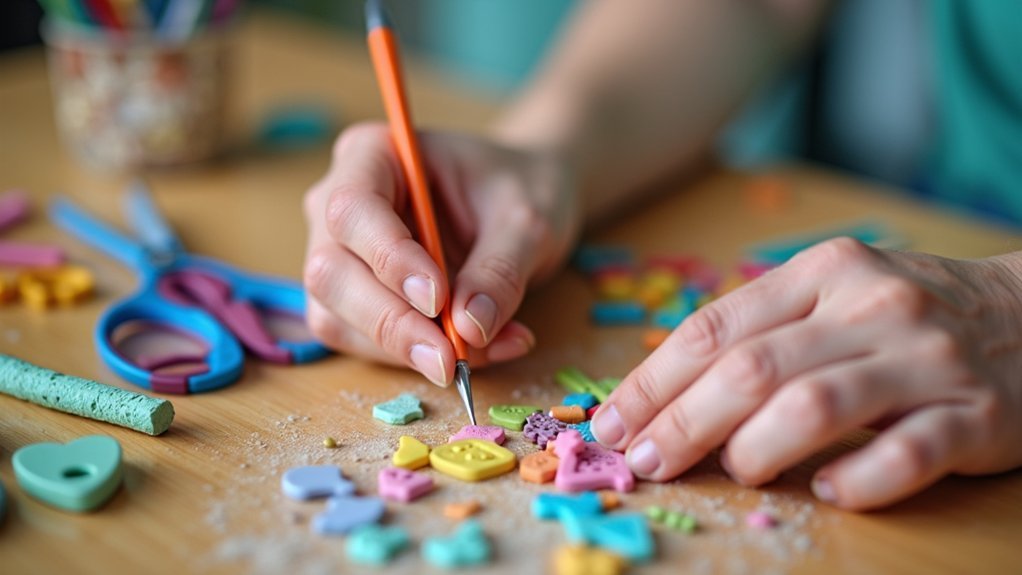Various coordination tools can notably ease arthritis pain and improve your daily functioning. Kitchen gadgets with built-up handles reduce strain, while dressing aids like sock helpers and buttoning devices prevent painful joint movements. Smart home devices minimize physical effort, and balance support tools like ergonomic canes enhance mobility. For hobbies, consider adaptive equipment with larger grips for activities like knitting or gardening. These specialized tools can transform painful tasks into manageable ones while protecting your vulnerable joints.
Adaptive Kitchen Tools for Improved Grip and Balance

When arthritis pain flares up, everyday kitchen tasks can become challenging obstacles rather than simple routines. You’ll find relief with adaptive kitchen tools designed specifically to reduce joint stress during meal preparation.
Utensils with built-up handles enhance your grip strength while minimizing finger strain. Electric can openers eliminate the painful twisting motions that manual openers require. For stubborn jars, both fixed and rubber jar openers provide leverage without taxing your hands.
Arthritis-friendly kitchen tools transform painful daily tasks into manageable moments, protecting your joints while preserving your cooking independence.
Maintain your independence in cooking by using long-handled reachers to access items on high or low shelves, preventing dangerous stretching that could lead to falls.
Weighted utensils with ergonomic designs offer improved stability and control, letting you continue preparing favorite meals despite arthritis pain. These thoughtful adaptations help preserve your kitchen autonomy while protecting your joints.
Dressing and Self-Care Aids That Reduce Joint Strain
Getting dressed and managing personal care routines can become painful challenges when arthritis affects your joints. Fortunately, specialized self-care aids can greatly reduce joint strain and restore your independence.
Dressing sticks help you put on shirts, jackets, and pants without overextending your joints. When struggling with socks, foam-handled sock aids eliminate the need to bend, minimizing lower extremity discomfort.
For fastening clothing, zipper pulls and buttoning aids provide larger grip surfaces, compensating for weakened hand strength. Long-handled shoehorns let you put on shoes without bending, alleviating stress on hip and knee joints during this daily task.
Consider investing in adaptive clothing featuring Velcro fasteners and wider openings for easier dressing. These thoughtfully designed tools work together to decrease arthritis pain while maintaining your dignity and self-sufficiency.
Movement-Enhancing Devices for Home and Outdoor Activities

Despite the limitations arthritis can impose, specialized movement-enhancing devices can dramatically improve your ability to navigate both home and outdoor environments.
Long-handled reachers let you grab items without straining your joints, while smart home devices controlled by voice commands reduce the physical effort needed for daily activities like adjusting lights or thermostats.
When venturing outdoors, specialized walking aids with ergonomic grips and shock-absorbing features provide stability and reduce joint pain during movement.
If you enjoy gardening, adaptive gardening tools such as lightweight hoses and kneelers make this activity accessible while minimizing discomfort.
At home, non-slip mats and adaptive utensils enhance safety during meal preparation.
These mobility aids collectively help you maintain independence and reduce pain from arthritis during everyday tasks.
Balance Support Tools for Daily Mobility and Exercise
Beyond movement-enhancing devices, balance support tools play an integral role in maintaining stability and preventing falls for people with arthritis.
These ergonomic designs, including canes, walkers, and crutches, offer adjustable features that accommodate your specific needs while providing vital support during daily mobility challenges.
When incorporating balance support tools into your routine, you’ll:
- Notably reduce your fall risk, giving you confidence to maintain an active lifestyle despite arthritis limitations
- Improve your coordination and joint stability through proper body alignment during movement
- Strengthen core muscles through specialized balance devices like stability balls and balance boards
These tools aren’t just for walking—they’re valuable exercise companions that enhance your overall stability while protecting painful joints during physical activity, ultimately improving your quality of life.
Therapeutic Hobby Equipment for Hand Coordination

Four innovative categories of therapeutic hobby equipment have revolutionized how arthritis sufferers maintain hand coordination while enjoying their favorite pastimes.
No-hands quilting frames enable you to pursue needlework without straining painful joints, while adaptive tools featuring larger grips for knitting needles and crochet hooks reduce discomfort during crafting sessions.
When you’re in the mood for games, specially designed card holders and automatic shufflers make playing cards accessible again.
For writing enthusiasts, ergonomic pens with enhanced grips help preserve fine motor skills while managing pain.
Don’t abandon your garden—specialized gardening tools with padded handles and extended shafts allow you to tend plants while protecting your joints.
These assistive devices aren’t just about pain management; they’re about maintaining the hand coordination activities that bring you joy.
Frequently Asked Questions
What Can You Do for Unbearable Arthritis Pain?
For unbearable arthritis pain, you’ll benefit from physical therapy, weight management, and low-impact exercises. Try mindfulness meditation, use assistive devices, and don’t hesitate to consult your doctor about pain management options.
What Are the Assistive Devices for Arthritis Pain?
You’ll find relief with jar openers, reachers, adaptive utensils, kitchen aids with built-up handles, button hooks, grab bars, raised toilet seats, canes, walkers, and compression gloves. These devices reduce joint strain during daily activities.
What Is the New Miracle Drug for Arthritis?
There’s no single “miracle drug” for arthritis yet. You’ll find JAK inhibitors like upadacitinib and biologics showing promise. These treatments target specific immune pathways, but they’re not universal cures for everyone.
What Is the Best Pain Reliever for Arthritis?
The best pain reliever for arthritis depends on your specific needs. You’ll likely find relief with NSAIDs like ibuprofen, acetaminophen for mild pain, or prescription medications for severe cases. Consult your doctor for personalized recommendations.
In Summary
With so many adaptive tools now available, you’ll find daily activities no longer need to trigger pain or frustration. These specialized devices don’t just help with practical tasks—they empower you to maintain independence and enjoy favorite activities despite arthritis challenges. By incorporating these coordination tools into your routine, you’re taking a proactive step toward managing symptoms while preserving your quality of life and personal dignity.





Leave a Reply